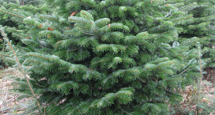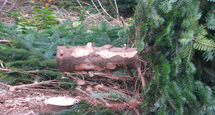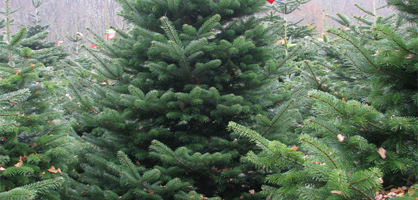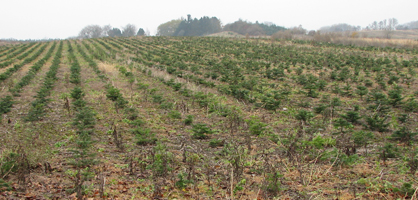
History of Nordmann fir
Nordmann fir is native to mountainous areas south and east of the Black Sea in Turkey, Georgia and Russia. It was introduced to Denmark for almost 150 years ago.
Originally intended as a supplement to noble fir in heath and dune forest, but only when you look up in the 1950s became aware of its suitability as greenery and as a Christmas tree slowly got its present importance. Nordmann fir, like noble fir major problems in culture start, particularly in relation to spring and winter frost and lice. It is mainly used for Christmas trees (fir), and is especially suitable for Christmas trees and production of ornamental foliage, and to Solitary trees.

Nordmannsgran (Abies nordmanniana)
Nordmann fir is a large, evergreen tree with a broad, cone-shaped growth. Very old trees may be domed with a flat crown. The bark is first very light green changing to brown and lastly grey. Stem bark is smooth, but without the resin-filled blisters, which otherwise is a hallmark of Abies species. The needles are rising and leathery.
They are distributed so that only the bottom of the shot is flat (as opposed Common Fir, where the needles form flat shot with "midterskilning"). At the head is a small but clearly notches. The upper side is dark green and glossy, while the underside carries two white-blue stripes. The cones are set up and cylindrical. They are seen after 15-20 years. The seeds ripen from time to time in Denmark, but they germinate only under the right conditions. Nordmannsgrannen is the most popular Christmas tree in Denmark, followed by rødgrannen. It is most popular because the wood is rarely loses its needles after it is felled.

Leaves and blooms
The needles are 2 - 3 cm long, dark green and glossy. They have two white stripes on the underside. The needles are positioned so that they form a small arch across the branch. Female flowers on the upper side of the branch in charge of last year's shoots. The male flowers are many along the underside. Female flowers bloom first. When they have been pollinated by pollen from other trees, jumping male flowers out. The cones stand vertically from the branches. They are a little barrel-shaped. When a cone is ripe, it falls apart and the seeds spread by the wind.

Plantning
Spring Planting of Nordmann fir can happen in March / April and until early May. First period, make sure that the ground is frost free and sufficiently warm. At the end of the period must be aware of the risk of spring drought. Fall planting can take place from late August to early October, but should not be made on the premises without shelter.
On arable land is machine planting quick and inexpensive. The larger the area the more effective is the solution. Only use heavy machinery to ensure that the plants get a good ground and pressed properly to the roots. In small areas, in many forest cultures and wherever you find it difficult to get to, planted with a spade. For larger forest cultures and second-generation field cultures have developed machines, so planting can be done despite pulp and shock from the previous Christmas tree culture. Exact planting facilitates the subsequent cleaning significantly, whether in the case of mechanical weeding or shielded spraying.
